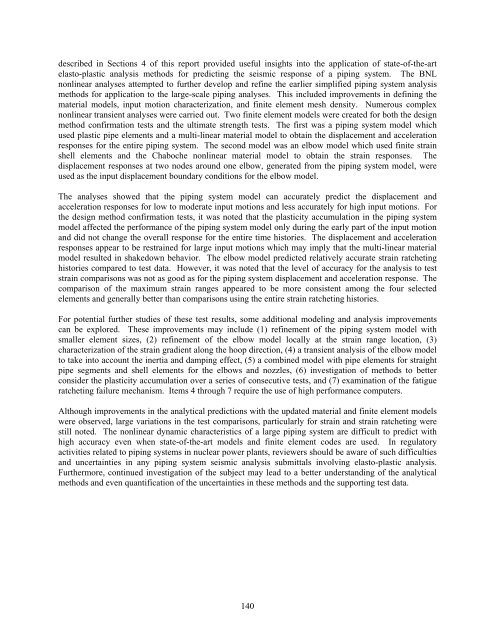Seismic Analysis of Large-Scale Piping Systems for the JNES ... - NRC
Seismic Analysis of Large-Scale Piping Systems for the JNES ... - NRC
Seismic Analysis of Large-Scale Piping Systems for the JNES ... - NRC
You also want an ePaper? Increase the reach of your titles
YUMPU automatically turns print PDFs into web optimized ePapers that Google loves.
described in Sections 4 <strong>of</strong> this report provided useful insights into <strong>the</strong> application <strong>of</strong> state-<strong>of</strong>-<strong>the</strong>-art<br />
elasto-plastic analysis methods <strong>for</strong> predicting <strong>the</strong> seismic response <strong>of</strong> a piping system. The BNL<br />
nonlinear analyses attempted to fur<strong>the</strong>r develop and refine <strong>the</strong> earlier simplified piping system analysis<br />
methods <strong>for</strong> application to <strong>the</strong> large-scale piping analyses. This included improvements in defining <strong>the</strong><br />
material models, input motion characterization, and finite element mesh density. Numerous complex<br />
nonlinear transient analyses were carried out. Two finite element models were created <strong>for</strong> both <strong>the</strong> design<br />
method confirmation tests and <strong>the</strong> ultimate strength tests. The first was a piping system model which<br />
used plastic pipe elements and a multi-linear material model to obtain <strong>the</strong> displacement and acceleration<br />
responses <strong>for</strong> <strong>the</strong> entire piping system. The second model was an elbow model which used finite strain<br />
shell elements and <strong>the</strong> Chaboche nonlinear material model to obtain <strong>the</strong> strain responses. The<br />
displacement responses at two nodes around one elbow, generated from <strong>the</strong> piping system model, were<br />
used as <strong>the</strong> input displacement boundary conditions <strong>for</strong> <strong>the</strong> elbow model.<br />
The analyses showed that <strong>the</strong> piping system model can accurately predict <strong>the</strong> displacement and<br />
acceleration responses <strong>for</strong> low to moderate input motions and less accurately <strong>for</strong> high input motions. For<br />
<strong>the</strong> design method confirmation tests, it was noted that <strong>the</strong> plasticity accumulation in <strong>the</strong> piping system<br />
model affected <strong>the</strong> per<strong>for</strong>mance <strong>of</strong> <strong>the</strong> piping system model only during <strong>the</strong> early part <strong>of</strong> <strong>the</strong> input motion<br />
and did not change <strong>the</strong> overall response <strong>for</strong> <strong>the</strong> entire time histories. The displacement and acceleration<br />
responses appear to be restrained <strong>for</strong> large input motions which may imply that <strong>the</strong> multi-linear material<br />
model resulted in shakedown behavior. The elbow model predicted relatively accurate strain ratcheting<br />
histories compared to test data. However, it was noted that <strong>the</strong> level <strong>of</strong> accuracy <strong>for</strong> <strong>the</strong> analysis to test<br />
strain comparisons was not as good as <strong>for</strong> <strong>the</strong> piping system displacement and acceleration response. The<br />
comparison <strong>of</strong> <strong>the</strong> maximum strain ranges appeared to be more consistent among <strong>the</strong> four selected<br />
elements and generally better than comparisons using <strong>the</strong> entire strain ratcheting histories.<br />
For potential fur<strong>the</strong>r studies <strong>of</strong> <strong>the</strong>se test results, some additional modeling and analysis improvements<br />
can be explored. These improvements may include (1) refinement <strong>of</strong> <strong>the</strong> piping system model with<br />
smaller element sizes, (2) refinement <strong>of</strong> <strong>the</strong> elbow model locally at <strong>the</strong> strain range location, (3)<br />
characterization <strong>of</strong> <strong>the</strong> strain gradient along <strong>the</strong> hoop direction, (4) a transient analysis <strong>of</strong> <strong>the</strong> elbow model<br />
to take into account <strong>the</strong> inertia and damping effect, (5) a combined model with pipe elements <strong>for</strong> straight<br />
pipe segments and shell elements <strong>for</strong> <strong>the</strong> elbows and nozzles, (6) investigation <strong>of</strong> methods to better<br />
consider <strong>the</strong> plasticity accumulation over a series <strong>of</strong> consecutive tests, and (7) examination <strong>of</strong> <strong>the</strong> fatigue<br />
ratcheting failure mechanism. Items 4 through 7 require <strong>the</strong> use <strong>of</strong> high per<strong>for</strong>mance computers.<br />
Although improvements in <strong>the</strong> analytical predictions with <strong>the</strong> updated material and finite element models<br />
were observed, large variations in <strong>the</strong> test comparisons, particularly <strong>for</strong> strain and strain ratcheting were<br />
still noted. The nonlinear dynamic characteristics <strong>of</strong> a large piping system are difficult to predict with<br />
high accuracy even when state-<strong>of</strong>-<strong>the</strong>-art models and finite element codes are used. In regulatory<br />
activities related to piping systems in nuclear power plants, reviewers should be aware <strong>of</strong> such difficulties<br />
and uncertainties in any piping system seismic analysis submittals involving elasto-plastic analysis.<br />
Fur<strong>the</strong>rmore, continued investigation <strong>of</strong> <strong>the</strong> subject may lead to a better understanding <strong>of</strong> <strong>the</strong> analytical<br />
methods and even quantification <strong>of</strong> <strong>the</strong> uncertainties in <strong>the</strong>se methods and <strong>the</strong> supporting test data.<br />
140
















